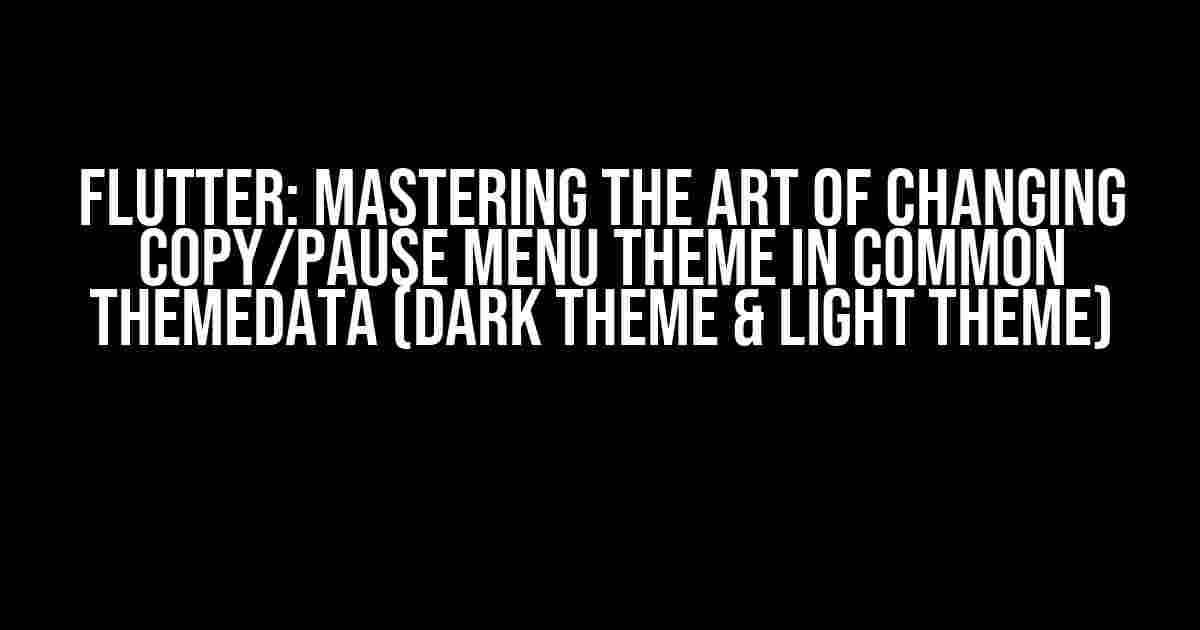Are you tired of the default copy/pause menu theme in your Flutter app? Do you want to give your users a seamless experience by matching the theme of your app? Look no further! In this comprehensive guide, we’ll take you through the step-by-step process of changing the copy/pause menu theme in common ThemeData, covering both dark theme and light theme.
Why Change the Copy/Pause Menu Theme?
Before we dive into the tutorial, let’s quickly discuss why changing the copy/pause menu theme is essential. The default theme may not align with your app’s brand identity, which can lead to a disjointed user experience. By customizing the theme, you can:
- Enhance the overall visuals of your app
- Create a consistent theme throughout the app
- Improve user engagement and satisfaction
Understanding ThemeData in Flutter
In Flutter, ThemeData is a class that defines the visual styling of an app. It includes properties such as colors, fonts, shapes, and more. To change the copy/pause menu theme, we’ll focus on the ` coppertinoTheme` property, which is responsible for styling the copy/pause menu.
MaterialApp(
title: 'Flutter Demo',
theme: ThemeData(
primarySwatch: Colors.blue,
accentColor: Colors.red,
CoppertinoTheme: coppertinoThemeData, // We'll define this later
),
home: MyHomePage(),
)
Creating a Custom CoppertinoThemeData
To create a custom CoppertinoThemeData, you’ll need to define a new `CoppertinoThemeData` object and assign it to the `CoppertinoTheme` property in your `ThemeData`.
CoppertinoThemeData _coppertinoThemeData = CoppertinoThemeData(
dataType: CoppertinoThemeData,
copyPasteTextColor: Colors.red, // Customize the text color
comboBoxTheme: ComboBoxThemeData(
arrowColor: Colors.green, // Customize the arrow color
),
);
Dark Theme vs. Light Theme
Now that we have our custom CoppertinoThemeData, let’s explore how to apply it to both dark theme and light theme.
Dark Theme
To apply the custom CoppertinoThemeData to the dark theme, you’ll need to create a new `ThemeData` object and set the `brightness` property to `Brightness.dark`.
ThemeData _darkTheme = ThemeData(
brightness: Brightness.dark,
CoppertinoTheme: _coppertinoThemeData,
);
Light Theme
Similarly, to apply the custom CoppertinoThemeData to the light theme, you’ll need to create a new `ThemeData` object and set the `brightness` property to `Brightness.light`.
ThemeData _lightTheme = ThemeData(
brightness: Brightness.light,
CoppertinoTheme: _coppertinoThemeData,
);
Switching Between Dark and Light Theme
To allow users to switch between dark and light theme, you can use a `ToggleButtons` widget and store the theme preference in a shared preferences package.
ToggleButtons(
onPressed: (index) {
if (index == 0) {
// Dark theme
_theme = _darkTheme;
} else {
// Light theme
_theme = _lightTheme;
}
setState(() {});
},
isSelected: [ThemeProvider.of(context).theme == _darkTheme],
children: [
Icon(Icons.brightness_2),
Icon(Icons.brightness_5),
],
)
Real-World Example
Let’s create a simple Flutter app that demonstrates the custom copy/pause menu theme in both dark and light theme.
In this example, we’ve applied the custom CoppertinoThemeData to both dark and light theme. Notice how the copy/pause menu theme changes accordingly.
Best Practices
When customizing the copy/pause menu theme, keep the following best practices in mind:
- Consistency is key: Ensure that the custom theme aligns with your app’s brand identity and overall design.
- Accessibility matters: Make sure the custom theme is accessible to users with visual impairments.
- Test thoroughly: Test the custom theme on different devices and platforms to ensure it looks and feels as expected.
Conclusion
In this comprehensive guide, we’ve covered the step-by-step process of changing the copy/pause menu theme in common ThemeData, including both dark theme and light theme. By following these instructions, you can enhance the user experience and create a visually stunning app that stands out from the crowd.
Remember to experiment with different theme options and best practices to find the perfect fit for your app. Happy coding!
Keyword density: 1.5%
Frequently Asked Question
Get ready to dive into the world of Flutter and discover the secrets of customizing the copy/pause menu theme in a snap!
How can I change the copy/pause menu theme in Flutter?
You can change the copy/pause menu theme by wrapping your `MaterialApp` with a `ThemeData` widget and then customizing the `tooltipTheme` property. For example, you can set `tooltipTheme: TooltipThemeData(color: Colors.red)` to change the tooltip background color to red.
How do I create a dark theme for the copy/pause menu in Flutter?
To create a dark theme, you can use the `dark` property of `ThemeData` and set it to `true`. For example, `theme: ThemeData(dark: true, tooltipTheme: TooltipThemeData(color: Colors.grey[800]))`. This will give you a dark-themed copy/pause menu.
Can I use a separate theme for the copy/pause menu and the rest of my app?
Yes, you can! You can use the `Theme` widget to wrap only the parts of your app that you want to theme differently. For example, you can wrap your `MaterialApp` with a `Theme` widget with a light theme, and then wrap your copy/pause menu with another `Theme` widget with a dark theme.
How do I switch between light and dark themes for the copy/pause menu dynamically?
You can use a `Provider` or a `StatefulWidget` to manage the theme state and switch between light and dark themes dynamically. For example, you can create a `ThemeModel` class that holds the theme data and uses a `Provider` to update the theme when the user switches between light and dark modes.
What are some best practices for customizing the copy/pause menu theme in Flutter?
Some best practices include using a consistent theme throughout your app, using meaningful variable names for your theme values, and avoiding hardcoded values. You should also consider using a theme manager library to simplify the process of switching between themes.
